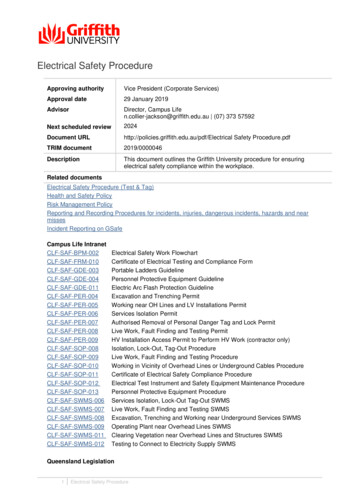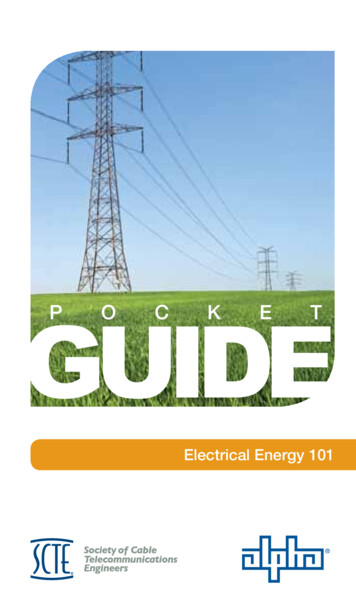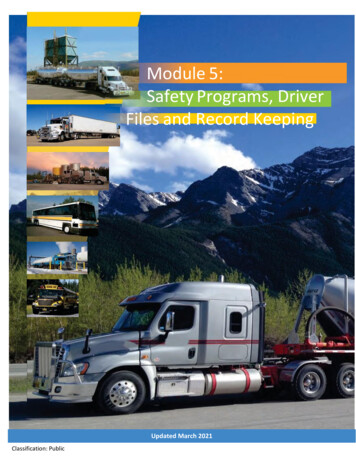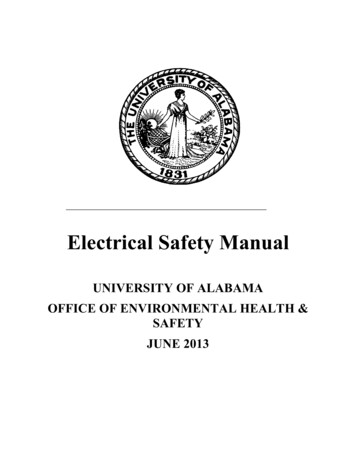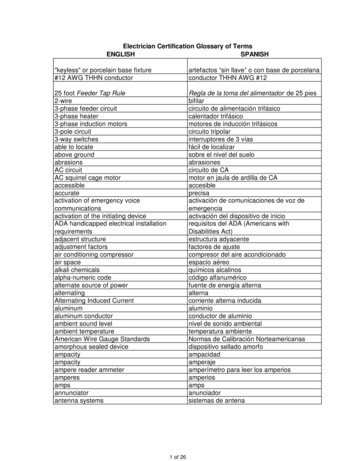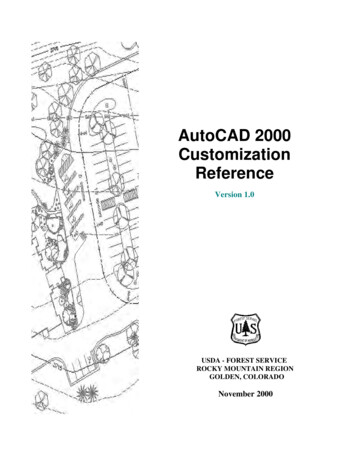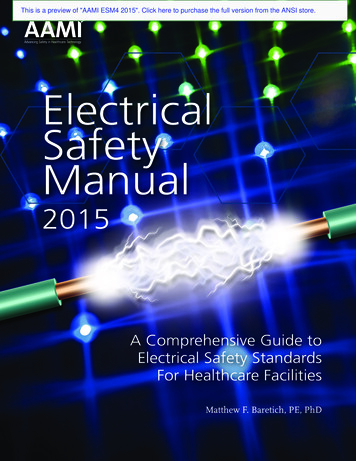
Transcription
Keeping Up with ElectricalSafetyAndrew Olsen
Dynamic Industry Changing Technology Changing Hazards Changing Safety Cultures Safety Programs need to be dynamic as well
NFPA 70E Requirements Annual Field Work Audit Electrical Safety Program Audit – every 3 years Electrical Safety Retraining – every 3 years
110.6(A)(1) Qualified Person(f) The employer shall determine through regular supervision orthrough inspections conducted on at least an annual basis that eachemployee is complying with the safety-related work practices requiredby this standard.
Electrical Safety InspectionsProvide: Assessment of Culture Effectiveness of Training Compliance with Electrical Safety Program Deficiencies of the Electrical Safety Program Evidence to support needed changes
Third Party ObservationsWe tend to walk past issues when they are in front of us every day.
Common Observations:
Labeling: Arc Flash LabelsImproper Working DistanceExpired Dates ( 5 years)
Labeling: Arc Flash LabelsCrossed Out LabelsBlank Labels
Labeling: Arc Flash LabelsUnlabeled Equipment
Labeling: Arc Flash LabelsWarning vs Danger Labels Inconsistent
GFCIs:Extension Cords without GFCI
GFCIs:Receptacles within 6’ of sink edge
Missing Fasteners:
AEGCP
Missing Covers: Weatherproof Covers
Missing Covers: Face Plates
Missing Covers: Equipment Covers
Modified Equipment:
Unplugged Openings
Daisy Chaining: Industrial Locations
Daisy Chaining: Machine Areas
Daisy Chaining: Office Spaces
Open Covers: In-Progress Work?
Open Covers: Forgotten?
Open Covers: No Deadfront Panels
Broken Ground Prongs
Improper Installation Techniques
Improper Installation Techniques
2-wire adapters and extension cords
Maintaining Equipment SpaceEquipment Access
Maintaining Equipment SpaceTransformer Surfaces
Inspection Results Not meant to be punitive or to just focus on what's wrong The information can be used to identify opportunities forimprovement Encourage Ownership Provide observations and compliance requirements Ask AHJ or committee how they want to address the issue so they own theactions and policy changes and are more likely to internalize it.
Inspection Process Lessons Learned Started with Camera and Note Taking Transitioned to an online safety software Developed custom inspection software
Keeping up with Electrical Safety –Changing Standards NFPA 70E publishes new edition every 3 years. Simplified boundaries and requirementsSimplified tablesNew AnnexesNew articles We’ll provide the example of Capacitors (Article 360)
Capacitors Definitions Hazard Thresholds New Boundaries Guidance for grounding New Calculations
Definitions included in 360Arc Blast HazardBleed ResistorCharge TransferDielectric AbsorptionDischarge TimeGround StickHard Grounding (Low-Z)Hearing Protection BoundaryLung Protection BoundarySoft Grounding (High-Z)Time Constant
Capacitor Hazard Thresholds360.3 Stored Energy Hazard Thresholds. Appropriate controls shall beapplied where any of the following hazard thresholds are exceeded: 100 volts and 100 joules of stored energy 100 volts and 1.0 joule of stored energy 400 volts and 0.25 joules of stored energy
Calculating JoulesEnergy½ CV2 Joules.5 * 1.0F * 5.5V2 15.125JWhat wouldhappen if thevoltage wasincreased to 25volts?.5 * 1F * 25 V2 312.5JHazard Thresholds: 100 volts and 100 joules of stored energy 100 volts and 1.0 joule of stored energy 400 volts and 0.25 joules of stored energy39
Capacitor LabelingIf 100 volts and 10 joules, field mark with label containing:1. “WARNING” on orange background2. Stored energy in joules and max voltage3. Required wait time before opening the enclosure4. Date of stored energy analysis5. Qualified person is necessary and they should use a writtendischarge procedure
Grounding Instruction If bleed resistors or automatic discharge systems are applicable, waitthe prescribed time for the capacitors to discharge to less then thethresholds in 360.3 For systems without bleed resistors or automatic discharge systems,discharge the capacitors with an adequately rated grounding device. Soft grounding shall be performed above 1000 J, and remote soft grounding shall be performed above 100 kJ.
Testing MethodsVerify that the capacitors are discharged. For capacitors less than 1000 J, verification shall be permitted to be doneeither by testing or by grounding. For capacitors between 1000J and less than 100 kJ, verification shall bedone using testing or soft grounding, then hard grounding. Above 100 kJ, an engineered and redundant system shall be used forremote testing and grounding. An adequately rated portable testinstrument shall be used to test between each capacitor terminal and fromeach terminal to ground to assure that the capacitor is deenergized.
Other Thresholds to remember: Voltage Rated PPEArc Flash PPEHearing protection if stored energy exceeds 100 joulesLung protection boundary established if stored energy is above 122kJ.
Capacitor Arc Flash FormulasBox:Open Air:𝑰𝑬𝒐𝒑𝒆𝒏 𝒂𝒊𝒓𝑬 𝒄𝒂𝒍/𝒄𝒎𝟐𝟐𝟓𝟐. 𝟔𝒓𝟏 𝟐𝑬 𝑪𝑽𝟐𝑨𝑭𝑩𝒐𝒑𝒆𝒏 𝒂𝒊𝒓 𝟎. 𝟎𝟓 𝑬(𝒊𝒏. )𝑰𝑬𝒃𝒐𝒙 𝟑 𝑰𝑬𝒐𝒑𝒆𝒏 𝒂𝒊𝒓𝑨𝑭𝑩𝒃𝒐𝒙 𝟑 𝑨𝑭𝑩𝒐𝒑𝒆𝒏 𝒂𝒊𝒓Where:𝐼𝐸 𝑖𝑛𝑐𝑖𝑑𝑒𝑛𝑡 𝑒𝑛𝑒𝑟𝑔𝑦𝐴𝐹𝐵 𝑎𝑟𝑐 𝑓𝑙𝑎𝑠ℎ 𝑏𝑜𝑢𝑛𝑑𝑎𝑟𝑦𝐸 𝑒𝑛𝑒𝑟𝑔𝑦𝐶 𝑐𝑎𝑝𝑎𝑐𝑖𝑡𝑎𝑛𝑐𝑒𝑉 𝑣𝑜𝑙𝑡𝑎𝑔𝑒𝑟 𝑟𝑎𝑑𝑖𝑢𝑠
Eardrum Rupture BoundaryThe arc blast hazard is directlyrelated to the instantaneous shortcircuit current.Since capacitors can discharge veryrapidly, the shockwave generated bya capacitor discharge can causebarotrauma (overpressure injury) tothe persons in the area.When a differential pressure acrossthe eardrums exceeds around 3-5psi, the eardrum can rupture.𝑬 𝟒𝟗. 𝟐𝟗 𝟓. 𝑅𝑒𝑎𝑟 eardrum rupture boundary (1%probability) in cm𝐸 𝑒𝑛𝑒𝑟𝑔𝑦
Lung Collapse BoundaryAt 29 psi, lung damage can occur.The following formula is used toestimate the safe boundary, where“safe” is less than 1% probability of lunginjury.𝑬 𝟑𝟏. 𝟑𝟐 𝟏𝟓𝟓. ere:𝑅𝑙𝑢𝑛𝑔 lung collapse boundary (1%probability) in cm𝐸 𝑒𝑛𝑒𝑟𝑔𝑦
Impact of Changes New Procedures with necessary steps and sequence for dischargingcapacitors and establish electrically safe working conditions New methods of discharging capacitors, new equipment New Labeling to identify hazardous capacitors New boundaries New calculations
Questions
Compliance with Electrical Safety Program . Developed custom inspection software. . and requirements Simplified tables New Annexes New articles We'll provide the example of Capacitors (Article 360) Capacitors Definitions Hazard Thresholds New Boundaries Guidance for grounding New Calculations.

